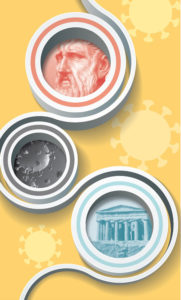On COVID-19 and Pandemics: A Secular Stoic Perspective

THE PANDEMIC experts long anticipated has now arrived, and it has quickly become a new reality for all of us. Welcome to the age of COVID-19. Predictably, you have already been exposed to a barrage of nonsensical or pseudoscientific notions about the novel coronavirus that causes COVID-19, and you have been told by certain incompetent government officials that there’s no reason to panic. Meanwhile, you’re worried about what might happen to you and your loved ones in the near future. For all these reasons, here is a Stoic guide to the present pandemic and—more generally—to any future pandemic. Keep it handy.
The way I’m going to tackle the issue is by using a threefold Stoic curriculum as it was taught in ancient schools, and which should resonate with a secular humanist. Namely, we are going to look at the epidemic from the point of view of physics, logic, and ethics.
“Physics,” for the Stoics, actually refers to a broad approach to the understanding of the world that includes what we nowadays call the natural sciences and metaphysics. Logic is also understood in a broader-than-usual sense, to mean anything to do with proper reasoning. Finally, ethics too has an enlarged meaning in Stoicism, as it encompasses not just the study of right and wrong, but our best understanding of how to live a human life that is actually worth living. That is to say, for the Stoics, a sound ethics is made possible by good physics and logic. Or, to put it differently, we live a good life if we use reason and evidence to navigate it. So, let’s get started!
The “physics” of COVID-19 (a.k.a. the coronavirus disease)
 The virus in question belongs to a family known as Coronaviridae, stemming from the Latin corōna, meaning “crown” (so named for the virus’s spiky appendages that suggest a garland or crown). Other coronaviruses include the common cold, as well as the lethal MERS and SARS. The common flu, by contrast, is not a coronavirus, as it belongs to a different family known as Orthomyxoviridae. And today’s scourge is technically abbreviated as SARS-CoV-2. Why does this matter? Because it helps us put this virus and the disease it causes in its proper biological context, telling us something about what it is and what it isn’t.
The virus in question belongs to a family known as Coronaviridae, stemming from the Latin corōna, meaning “crown” (so named for the virus’s spiky appendages that suggest a garland or crown). Other coronaviruses include the common cold, as well as the lethal MERS and SARS. The common flu, by contrast, is not a coronavirus, as it belongs to a different family known as Orthomyxoviridae. And today’s scourge is technically abbreviated as SARS-CoV-2. Why does this matter? Because it helps us put this virus and the disease it causes in its proper biological context, telling us something about what it is and what it isn’t.
Here are the basic facts regarding COVID-19 that we need to keep in mind:
1. There is no vaccine, nor will there be one available for likely a year.
2. There is no effective medication at the moment, though many scientific laboratories are working on a number of potential candidates.
3. The most practical things you can do are: (a) wash your hands carefully (for at least twenty seconds), especially after you’ve been outside, and particularly if you’ve come into contact with other people, for instance while using public transportation; (b) clean surfaces of everything that has been in contact with outside objects, including food; (c) stay at home if possible, even if you’re healthy but most definitely if you’re sick; (d) drink plenty of fluids. That’s pretty much it. Talk about a low-tech response to a twenty-first-century challenge.
4. Initially, the general medical advice was not to wear masks, unless you were sick or you were a health provider. That’s because masks do not filter the virus, since its particles are too small, but they reduce the chances that your mucus—if you are infected—will reach other people and infect them. However, new evidence now shows that people who are infected but asymptomatic are capable of transmitting the infection up to two days before showing symptoms, which means they should be wearing masks as well. It also appears, contrary to initial reports, that the virus may be airborne, which also makes wearing masks a reasonable precaution. That said, you should not wear medical-grade masks, because those are in limited supply and are needed by health workers who are on the front line of this fight.
5. The novel coronavirus is more contagious than seasonal influenza, SARS, hepatitis, or HIV, but less contagious than measles, chickenpox, or tuberculosis. That’s because droplets containing the coronavirus fall within a few feet from infected individuals, while in the latter three diseases the particles have a range of infection of one hundred feet. The reason the first four diseases are less contagious than COVID-19 is because seasonal flu is typically slowed down by vaccines, SARS was easier to contain after the initial outbreak, and hepatitis and HIV require direct transmission of bodily fluids.
6. The incubation period for the virus—that is, the time from infection to when symptoms are visible, and throughout which a person is capable of transmitting the infection—has been estimated to be between five and seven days (though estimates range from two to fourteen days). In comparison, the common flu has an incubation period of two to three days. This means there’s no way for you to know whether you have contracted the virus for several days, until the symptoms show up. Nor is there a way for you to know whether you’ve already come into contact with someone who is infected within the last several days.
7. In many cases, the symptoms of COVID-19 are pretty generic, hardly distinguishable from a cold or flu: fever, cough, and difficulty breathing. And again, some people who have the disease are asymptomatic.
8. The estimated fatality rate of COVID-19 is between 2 and 3 percent (give or take, with a fairly large margin of error, since data has been limited). Compare that to the fatality rate of the common flu (0.1 percent, which still translates to 35,000 annual deaths in the US alone), SARS (10 percent), and MERS (a whopping 33 percent!). As in general with respiratory viruses, your chances of being killed by an infection vary with age and health status. In the case of COVID-19, children do not seem to be at heightened risk, but elderly people, or people with health conditions, are. Analyses of data from China and Italy show a mortality rate of 8 percent for people in their seventies, and 15 percent for people in their eighties.
The ancient Stoics did not know any of this, of course. But they did have to deal with infectious diseases. Socrates (the chief inspiration for Stoic philosophy) lived in Athens during a plague that hit the city in the second year of the Peloponnesian War. He survived it, allegedly in part because he had a strong constitution and because his needs—in terms of food, drink, and social entertainment—were few. The emperor Marcus Aurelius, also a Stoic, had to handle the devastating effects of the Antonine Plague, probably smallpox brought back from the legions after the war against the Parthians on the eastern frontier of the empire. The plague was the worst in antiquity, causing millions to die.
The (Stoic) logic of COVID-19
 Now that we know the basic facts, let’s reason about them. In the first place, should we panic? Obviously not. Panic is an emotional overriding of reason, which means it is automatically a no-no for a Stoic practitioner. Moreover, worry should always be proportional to the actual facts.
Now that we know the basic facts, let’s reason about them. In the first place, should we panic? Obviously not. Panic is an emotional overriding of reason, which means it is automatically a no-no for a Stoic practitioner. Moreover, worry should always be proportional to the actual facts.
The chances of contracting the virus, even in the areas where it is currently widespread, are still moderate. Even if you do contract the virus, there are very good chances that you will recover, especially if you don’t have severe health conditions or are particularly old.
By the same token, reason also dictates not to be too casual about the danger. It is still a worrisome virus—especially for the subpopulations at heightened risk—and the rational thing to do is to respond in a measured way to the threat. That is, to deploy the Stoic virtue of temperance, doing things in the right way, neither overdoing it nor underdoing it.
Precisely because death is the norm, and may arrive at any moment, Stoics focus on the here and now, and particularly on appreciating what they have, and the people they love. It’s the most meaningful thing we can do as human beings.
In the case in question, this means following the recommendations given above, particularly about washing hands thoroughly and limiting exposure to others, as much as possible. Use what Marcus Aurelius called your “ruling faculty”—that is, reason—and don’t travel at all unless absolutely necessary. It is useful to keep in mind what the Stoics call the dichotomy of control:
Some things are within our power, while others are not. Within our power are opinion, motivation, desire, aversion, and, in a word, whatever is of our own doing; not within our power are our body, our property, reputation, office, and, in a word, whatever is not of our own doing.
(Epictetus, Enchiridion 1.1)
In modern language, this means that the only things that are really up to you are your considered judgments and your decisions to act or not to act. Everything else, ultimately, depends on external factors, and the only rational attitude toward those is to accept the notion that sometimes things in life go our way, at other times they don’t, despite our best efforts.
The (Stoic) ethics of COVID-19
 Finally, what does the above mean from an ethical perspective? As Stoics, we are cosmopolitan, which implies that we should be concerned for all members of the human cosmopolis. In practice, this means that, for instance, we shouldn’t hoard masks (or anything else, really) that we don’t need, as this may cause a shortage that may affect those who do need them—sick people and health care workers.
Finally, what does the above mean from an ethical perspective? As Stoics, we are cosmopolitan, which implies that we should be concerned for all members of the human cosmopolis. In practice, this means that, for instance, we shouldn’t hoard masks (or anything else, really) that we don’t need, as this may cause a shortage that may affect those who do need them—sick people and health care workers.
It’s also incumbent on us not to expose others to the virus. So, we have an ethical duty not to go to work if we’re sick. We moreover have an obligation to help others reason, and not panic, about what’s going on. And it would be consistent with Stoic virtue, I think, to donate money to organizations that are helping combat the pandemic (food pantries, and other humanitarian relief NGOs, for instance), especially in countries that are soon likely to be hit and have insufficient medical resources, like many places in Africa.
What if, after all of this, we are actually struck by the virus? In that case, we of course will follow all recommended medical procedures. But we will also keep in mind the dichotomy of control: our considered judgments and our decisions to act or not to act are up to us, but outcomes are not. That includes, of course, health outcomes.
Even when sick, we should treat others kindly, particularly our caretakers, like doctors, nurses, etc. After all, they’re there to help us and are doing a very stressful job. More broadly, however, it’s precisely when circumstances are dire that we get to exercise our virtue. And a pandemic is most definitely a dire circumstance.
We also have to face the possibility that there will be sustained shortages, hardship, and deaths. Including of loved ones. Death, for the Stoics, is a natural and inevitable occurrence, and moreover, there is no such thing as “premature” death: we depart as determined by the cosmic web of cause and effect, not a minute too soon nor one too late. The Stoic literature is rich on this topic. You can read much of Marcus Aurelius’s Meditations as a reflection on impermanence and how to best relate to it. Several letters that Seneca wrote to his friend Lucilius tackle the same issue, and he wrote three separate letters of consolation, two of which—to his friends Marcia and Polybius—were aimed at comforting for the loss of a loved one.
The Stoic take on death itself is similar to the Epicurean one, and both are akin to what a secular humanist would think:
He who fears death fears either the loss of sensation or a different kind of sensation. But if you shall have no sensation, neither will you feel any harm; and if you will acquire another kind of sensation, you will be a different kind of living being and you will not cease to live.
(Marcus Aurelius, Meditations 8.58)
Stoics even deploy a sense of humor to deal with the prospect: “Death is necessary and cannot be avoided. I mean, where am I going to go to get away from it?” (Epictetus, Discourses 1.17.7)
Yet, precisely because death is the norm and may arrive at any moment, Stoics focus on the here and now and particularly on appreciating what they have, and the people they love. It’s the most meaningful thing we can do as human beings, and let the rest be as it may. This isn’t nihilism or defeatism: it’s an attitude that requires the courage to look at things as they are, as well as the wisdom to appreciate and enjoy what we have, while we have it.
COVID-19 will not be a civilization-ending event. Though even at that level the Stoics were somberly realistic. Subscribing to what today is known as process metaphysics, an approach that began with the pre-Socratic philosopher Heraclitus, they understood that change is the inevitable norm in the universe. The world will look different after the current pandemic. But not unrecognizably so. And our task is going to be to rebuild it and make it better than it was before.
In the end, as Seneca puts it:
The storm does not interfere with the pilot’s work, but only with his success.…It is indeed so far from hindering the pilot’s art that it even exhibits the art; for anyone, in the words of the proverb, is a pilot on a calm sea.
(Letters to Lucilius, 85.33)
Read more articles in our Philosophy in the Time of Pandemic series.
Published in the May / June 2020 Humanist
